
Prostanthera eurybioides, commonly known as Monarto mintbush, is a species of flowering plant in the family Lamiaceae and is endemic to the south-east of South Australia. It is a low, spreading shrub with densely hairy branches, thick, elliptic to egg-shaped leaves clustered on short shoots, and violet to mid-purple flowers that are white with orange and dark purple dots inside the petal tube.

Prostanthera nivea, commonly known as snowy mint-bush, is a species of flowering plant in the family Lamiaceae and is endemic to eastern Australia. It is a shrub with linear to cylindrical leaves and white flowers arranged in leaf axils near the ends of branchlets and is one of the mint-bushes that is not aromatic.

Prostanthera galbraithiae, commonly known as Wellington mint-bush, is a species of flowering plant in the family Lamiaceae and is endemic to Victoria in Australia. It is an erect or spreading shrub with densely hairy branches that are more or less square in cross-section, narrow egg-shaped or oblong leaves with the edges rolled under, and deep mauve to purple flowers with maroon dots inside the petal tube.

Prostanthera cryptandroides is a species of flowering plant in the family Lamiaceae and is endemic to eastern Australia. It is a low, spreading shrub with narrow egg-shaped leaves and lilac to mauve flowers arranged singly in leaf axils.
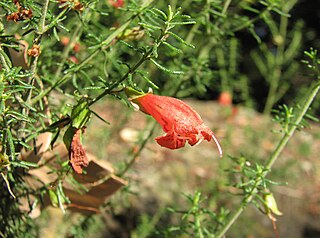
Prostanthera aspalathoides, commonly known as scarlet mint-bush, is a species of flowering plant that is endemic to south-eastern Australia. It is a small shrub with hairy branches, cylindrical or linear to elliptic or oblong leaves and red, pinkish red, or orange flowers arranged singly in leaf axils.
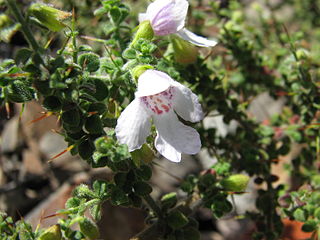
Prostanthera arapilensis is a flowering plant in the family Lamiaceae and is endemic to a small area of Victoria, Australia. It is an erect shrub with hairy branches, broadly egg-shaped to more or less round leaves and pale mauve or white flowers with orange-brown spots or streaks inside the petal tube.

Prostanthera walteri, commonly known as blotchy mint-bush, is a species of flowering plant that is endemic to south-eastern Australia. It is a sprawling shrub with tangled, hairy branches, egg-shaped leaves and usually bluish green flowers with prominent purple veins arranged singly in leaf axils.
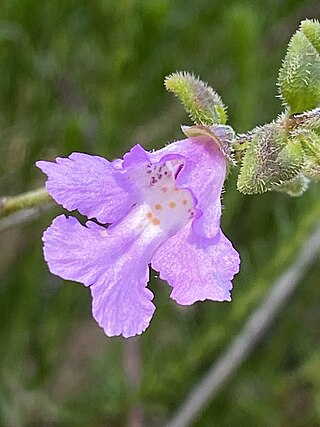
Prostanthera marifolia, commonly known as Seaforth mintbush, is a species of flowering plant that is endemic to a restricted area of New South Wales. It is a small, erect, openly branched shrub with egg-shaped to elliptic leaves, and purple to mauve flowers arranged in leaf axils.
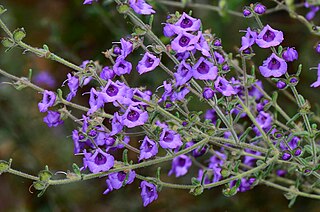
Prostanthera hirtula, commonly known as hairy mintbush, is a species of flowering plant in the family Lamiaceae and is endemic to the south-eastern continental Australia. It is a strongly aromatic, densely hairy, spreading shrub with narrow egg-shaped leaves and dark mauve flowers, and that grows in exposed, rocky sites.
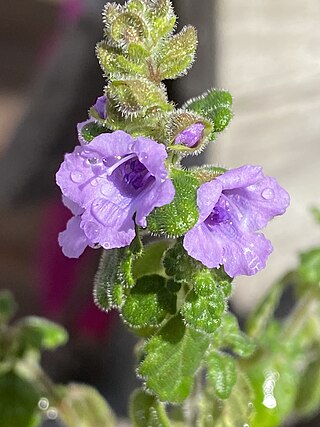
Prostanthera incana, commonly known as velvet mint-bush, is a species of flowering plant in the family Lamiaceae and is endemic to south-eastern continental Australia. It is an erect, moderately dense shrub with egg-shaped leaves, and lilac-coloured flowers, found mostly in near-coastal southern New South Wales.
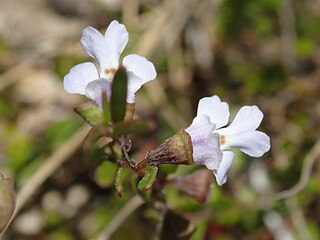
Prostanthera junonis, commonly known as Somersby mintbush, is a species of flowering plant in the family Lamiaceae and is endemic to the Central Coast of New South Wales. It is a low, straggling shrub with hairy, egg-shaped leaves and purple to mauve flowers.
Prostanthera athertoniana is a species of flowering plant in the family Lamiaceae and is endemic to a restricted area of Queensland. It is a small, densely-foliaged shrub with strongly aromatic, elliptical, oblong or egg-shaped leaves and hairy, purplish-mauve flowers arranged singly in upper leaf axils.

Prostanthera baxteri is a species of flowering plant in the family Lamiaceae and is endemic to the south-east of Western Australia. It is an erect shrub with narrow egg-shaped to linear leaves and white flowers with a tinge of blue to pale mauve.

Prostanthera canaliculata is a species of flowering plant in the family Lamiaceae and is endemic to the south-west of Western Australia. It is a small, erect shrub with hairy branchlets, narrow egg-shaped to narrow elliptical leaves and pale blue or pale violet to white flowers with no markings.

Prostanthera eungella is a species of flowering plant in the family Lamiaceae and is endemic to the Eungella region in Queensland. It is an erect shrub with narrow egg-shaped leaves with small teeth, and mauve flowers that are white inside the petal tube and arranged in upper leaf axils.
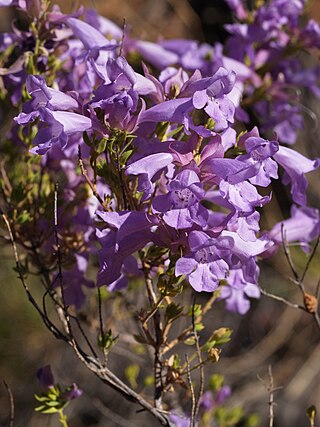
Prostanthera ferricola is a species of flowering plant in the family Lamiaceae and is endemic to central Western Australia. It is an erect, openly branched shrub with aromatic, egg-shaped leaves and mauve-purple flowers arranged in four to twelve leaf axils near the end of branchlets.

Prostanthera hindii is a species of flowering plant in the family Lamiaceae and is endemic to the Central Tablelands of New South Wales. It is a small, erect shrub with densely hairy branches, egg-shaped leaves, and mauve flowers with deep mauve to dark purple colouration inside the petal tube.
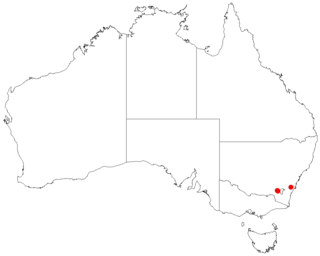
Prostanthera makinsonii is a species of flowering plant in the family Lamiaceae and is endemic to a restricted area of New South Wales. It is a spreading shrub with strongly aromatic, egg-shaped leaves and mostly glabrous purple flowers arranged in bunches of eight to twelve in upper leaf axils.

Prostanthera ringens, commonly known as gaping mint-bush, is a species of flowering plant in the family Lamiaceae and is endemic to eastern Australia. It is a bushy shrub with four-sided, hairy, densely glandular branches, oblong or egg-shaped leaves and pale blue to greenish or yellow flowers arranged singly in leaf axils.

Prostanthera violacea, commonly known as violet mint-bush, is a species of flowering plant in the family Lamiaceae and is endemic to south-eastern New South Wales. It is a slender, strongly aromatic shrub with densely hairy branches, more or less round leaves with the edges rolled under and mauve to bluish flowers often with white tips.



















